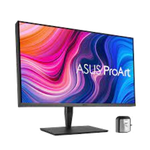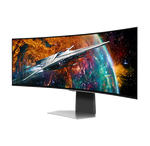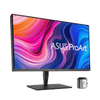A comparison of specs, key information, reviews, and best pricing from top retailers
Last updated -- hours ago | Report incorrect information
What we think

The PerfectRec monitor team Learn more
Updated April 12, 2024·
If you prioritize excellent color accuracy for professional photo and video editing, the Asus PA32UCG-K with its high brightness and wide color gamut will serve you well, despite its higher cost. However, if you're a gamer seeking a more immersive experience with a super wide screen and exceptional contrast, the Samsung Odyssey OLED G9, with its faster refresh rate and better gaming features, will be more enjoyable and cost-effective. The Samsung's larger size and curve might not suit typical office work as well as the Asus, which offers a more standard size and aspect ratio for productivity. Give Feedback
this description is based on the product variant with some specs and product variant with some specs. At the time of writing, the variant with some specs cost some dollars and the variant with some specs cost some dollars.
Advantages of the Asus PA32UCG-K (IPS MiniLED)
- Best in class for productivity
- Good text clarity
- Good image clarity
- Best in class brightness
Advantages of the Samsung Odyssey OLED G9 G95SC (QD-OLED)
- Best in class for casual gaming
- Excellent for media consumption
- Very good refresh rate
- Best in class contrast
- Best in class color volume
- Best in class response time
Key differences
Casual Gaming
8.3


9.6
3840 x 2160
RESOLUTION
5120 x 1440
120Hz
REFRESH RATE
240Hz
1000:1
NATIVE CONTRAST
Inf:1
1000 nits
SDR PEAK BRIGHTNESS
236 nits
1000 nits
HDR PEAK BRIGHTNESS
465 nits
98.0 %
DCI-P3 COLOR GAMUT
99.5 %
Matte
COATING
Glossy
The Samsung Odyssey OLED G9 G95SC (QD-OLED) is best in class for casual gaming, while the Asus PA32UCG-K (IPS MiniLED) is very good.
Competitive Gaming
4.4


5.6
120Hz
REFRESH RATE
240Hz
10.0 ms
TOTAL RESPONSE TIME
1.0 ms
48 - 120 Hz
VARIABLE REFRESH RATE
20 - 240 Hz
No
STROBING / BFI
Yes
1000 nits
SDR PEAK BRIGHTNESS
236 nits
The Samsung Odyssey OLED G9 G95SC (QD-OLED) and Asus PA32UCG-K (IPS MiniLED) are both poor for competitive gaming, though the Samsung Odyssey OLED G9 G95SC (QD-OLED) is somewhat better.
Productivity
9.8


5.6
3840 x 2160
RESOLUTION
5120 x 1440
137 PPI
PIXELS PER INCH
107 PPI
Yes
ADJUSTABLE STAND
Yes
Matte
COATING
Glossy
The Asus PA32UCG-K (IPS MiniLED) is best in class for productivity, while the Samsung Odyssey OLED G9 G95SC (QD-OLED) is poor.
Cost
$2,999


$1,200
$500
$1,000
$1,500
$2,000
$2,500
$3,000
$3,500
$4,000
The Asus PA32UCG-K (IPS MiniLED) has a price of $2,999 and the Samsung Odyssey OLED G9 G95SC (QD-OLED) costs $1,200.
HDR Video Editing and Color Grading
Yes


No
The Asus PA32UCG-K (IPS MiniLED) is suitable for HDR video editing and color grading while the Samsung Odyssey OLED G9 G95SC (QD-OLED) is not suitable for HDR video editing and color grading.
Key similarities
Media Consumption
8.8


9.2
3840 x 2160
RESOLUTION
5120 x 1440
1000:1
NATIVE CONTRAST
Inf:1
1000 nits
SDR PEAK BRIGHTNESS
236 nits
1000 nits
HDR PEAK BRIGHTNESS
465 nits
Matte
COATING
Glossy
Although they have very similar scores, PerfectRec considers Samsung Odyssey OLED G9 G95SC (QD-OLED) to be excellent for media consumption, while the Asus PA32UCG-K (IPS MiniLED) is very good.
HDR Gaming and Media Consumption
Yes


Yes
Both the Asus PA32UCG-K (IPS MiniLED) and Samsung Odyssey OLED G9 G95SC (QD-OLED) are suitable for HDR gaming and media consumption.
Digital Photo Editing
Yes


Yes
Both the Asus PA32UCG-K (IPS MiniLED) and Samsung Odyssey OLED G9 G95SC (QD-OLED) are suitable for digital photo editing.
Print Photo Editing
Yes


Yes
Both the Asus PA32UCG-K (IPS MiniLED) and Samsung Odyssey OLED G9 G95SC (QD-OLED) are suitable for print photo editing.
Give feedback
We’re constantly working to improve.
How the Asus PA32UCG-K (IPS MiniLED) and the Samsung Odyssey OLED G9 G95SC (QD-OLED) compare to other monitors
Spec Comparison
| Asus PA32UCG-K (IPS MiniLED) | Samsung Odyssey OLED G9 G95SC (QD-OLED) |
GENERAL | |||
|---|---|---|---|
| Price | |||
$2,999 | $1,200 | ||
Screen Size | |||
Screen Size | 32" | 49" | |
Resolution | |||
Resolution | 3840 x 2160 | 5120 x 1440 | |
Screen Type | |||
Screen Type | MiniLED | OLED | |
Screen Sub-type | |||
Screen Sub-type | IPS | QD-OLED | |
Local Dimming Zones | |||
Local Dimming Zones | 1152 | N/A | |
COLOR, CONTRAST & BRIGHTNESS | |||
|---|---|---|---|
Native Contrast | |||
Native Contrast | 1000:1 | Inf:1 | |
SDR Peak Brightness | |||
SDR Peak Brightness | 1000 nits | 236 nits | |
HDR Peak Brightness | |||
HDR Peak Brightness | 1000 nits | 465 nits | |
Suitable for HDR Gaming and Media Consumption | |||
Suitable for HDR Gaming and Media Consumption | Yes | Yes | |
sRGB Color Gamut | |||
sRGB Color Gamut | 100 % | 100 % | |
MOTION CHARACTERISTICS | |||
|---|---|---|---|
Total Response Time | |||
Total Response Time | 10 ms | 1 ms | |
Variable Refresh Rate | |||
Variable Refresh Rate | 48 - 120 Hz | 20 - 240 Hz | |
Strobing / BFI | |||
Strobing / BFI | No | Yes | |
Persistence Blur Score | |||
Persistence Blur Score | 6/10 | 8/10 | |
Ghosting Score | |||
Ghosting Score | 7.1/10 | 9.6/10 | |
TEXT & IMAGE CLARITY | |||
|---|---|---|---|
Pixels Per Inch | |||
Pixels Per Inch | 137 PPI | 107 PPI | |
Coating | |||
Coating | Matte | Glossy | |
Text Clarity Score | |||
Text Clarity Score | 7.9/10 | 6.6/10 | |
Image Clarity Score | |||
Image Clarity Score | 7.9/10 | 6.9/10 | |
PORTS & CONNECTIVITY | |||
|---|---|---|---|
HDMI 1.4 Ports | |||
HDMI 1.4 Ports | 0 | 0 | |
HDMI 2.0 Ports | |||
HDMI 2.0 Ports | 2 | 0 | |
HDMI 2.1 Ports | |||
HDMI 2.1 Ports | 1 | 1 | |
Micro HDMI Ports | |||
Micro HDMI Ports | 0 | 1 | |
DisplayPort 1.2 Ports | |||
DisplayPort 1.2 Ports | 0 | 0 | |
Shopping
Asus PA32UCG-K (IPS MiniLED)
See more
Dig into reviews and images
Tech Radar
Mark Pickavance | May 2021
"Combining features that designers and content makers need, the Asus ProArt PA32UCG-K Display represents the true cost of accurate colour. It’s expensive, heavy and has weird OSD controls, but the screen is glorious when working with HDR video or game graphics."
Give feedback
We're constantly perfecting our model
More comparisons for you
Compare Asus PA32UCG-K (IPS MiniLED) vs. LG 27EP950 (W-OLED)
VS
Compare Asus PA32UCG-K (IPS MiniLED) vs. LG 32EP950 (Inkjet OLED)
VS
Compare Asus PA32UCG-K (IPS MiniLED) vs. Asus PA32DC (Inkjet OLED)
VS
Compare Samsung Odyssey OLED G9 G95SC (QD-OLED) vs. Dell Alienware AW3225QF (QD-OLED)
VS
Compare Samsung Odyssey OLED G9 G95SC (QD-OLED) vs. Gigabyte FO32U2P (QD-OLED)
VS
Compare Samsung Odyssey OLED G9 G95SC (QD-OLED) vs. Acer Predator X45 (W-OLED)
VS
FAQs
Why trust us
This information was produced and vetted by the PerfectRec monitors team. We are a product research and recommendation organization that meticulously reviews and evaluates the latest monitor information and makes it digestible for you.
By the numbers
210
Monitors evaluated
10,500
Monitors stats compiled
15
Proprietary Monitors ratings developed
117,200
Recommendations made
17,580
Consumer hours saved
About the monitor team
Joe Golden, Ph.D
CEO and Monitors Editor
Joe is an entrepreneur and lifelong electronics enthusiast with a Ph.D in Economics from the University of Michigan.
Jason Lew
Staff Expert & Software Engineer
Jason is a staff expert and software engineer that has been making laptop recommendations for 7 years and moderates one of the largest laptop subreddits.
Chandradeep Chowdhury
Staff Expert & Software Engineer
Chandradeep is a staff expert and software engineer and expert in televisions and monitors. He’s been making monitor recommendations for ten years.







